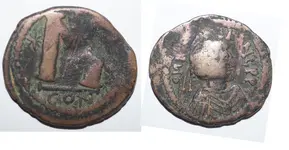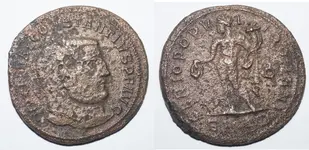Although it’s not legible in full, the legend on your second coin will read “ΚΟΙΝΟΝ ΜΑΚΕ∆ΟΝΩΝ”. The words are around a Macedonian shield in a double ring of pellets. It’s a common reverse type for Macedonian coins.
The term “koinon” variously translates as “community, alliance or league” and the “Koinon of the Macedonians” was a collective of self-governing regional communities united around a central leader, with its capital in the city of Beroia. Coins bearing this inscription were continuously produced from the time of Philip I in 238 BC until well into the Roman period.
Your coin is actually from the Roman period. Macedonia was conquered by Rome in 146 BC but the obverse (which has a Roman Emperor portrait) includes the word “KAICAP” in the legend, the Greek equivalent for the Latin “Caesar”. That puts it after AD 68, when the word first began to be used as a leadership title rather than a familial name. Unfortunately, the emperor name is obscured but it would be something like “AΔRIANOC KAICAP” for Hadrian, “NEPΩN KAICAP” for Nero, or whatever. It's tough to identify Roman emperors from the portrait alone, so I can’t say which emperor, except that it’s from someone who ruled after AD 68 and likely not much later than the end of the second century AD.
It was common practice for Rome not to erase the national identity of conquered provincial territories as long as civil order was maintained and taxes were paid. So, the coin shows a territory clearly under Roman Imperial rule but acknowledges the heritage of its people as Macedonians. At the end of the second century, the koinon was reorganized and largely absorbed into the Empire; any sense of Greek/Macedonian civic identity within the province had disappeared by the beginning of the fourth century.
Because of our modern uncertainties about the way Greek denominations were integrated into the Roman currency system, these copper/bronze coins are usually just catalogued by their diameter in millimetres, so Æ20 in this case.






